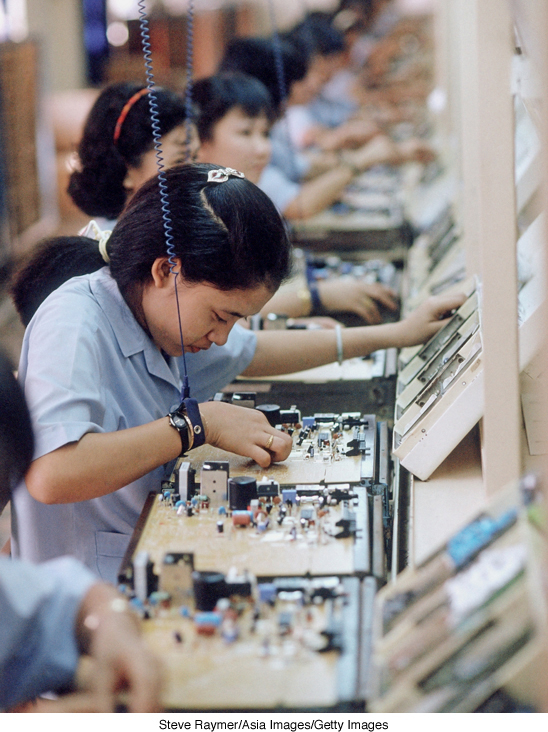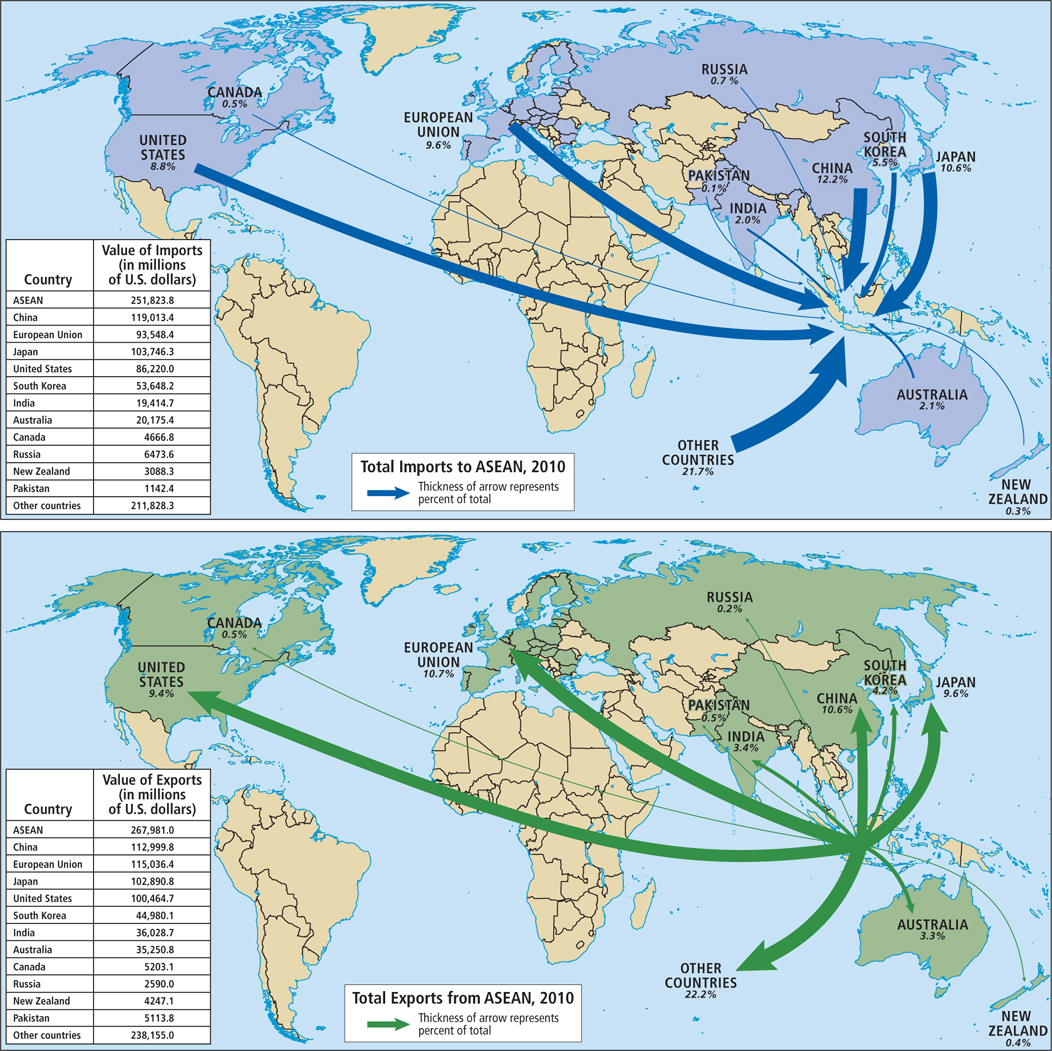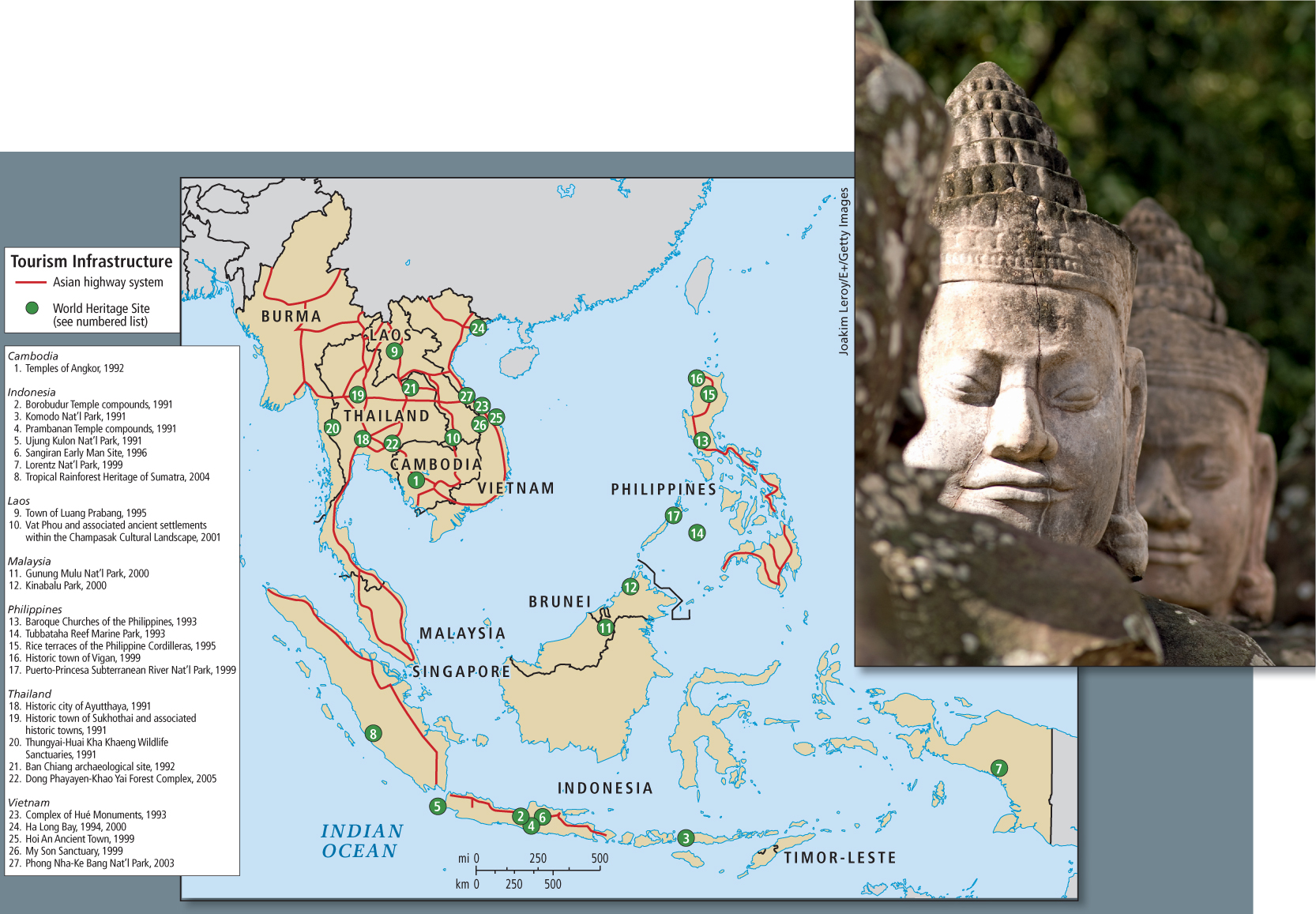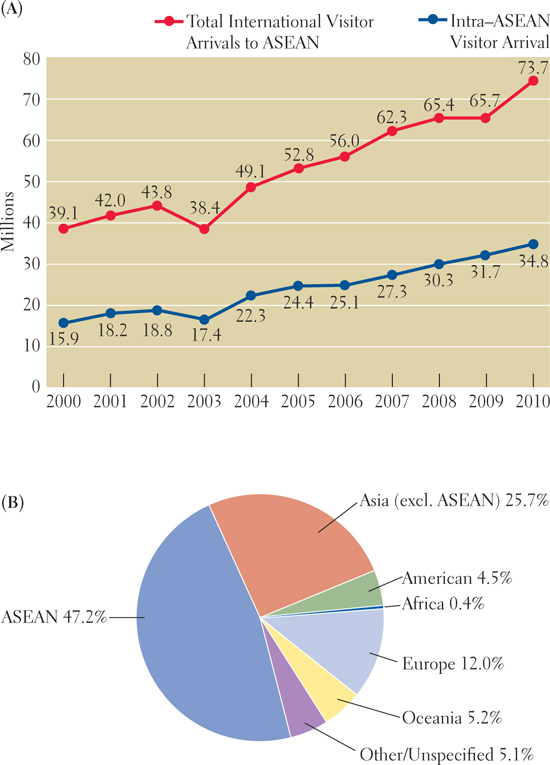10.5 GLOBALIZATION AND DEVELOPMENT
GEOGRAPHIC INSIGHT 2
Globalization and Development: Globalization has brought both spectacular successes and occasional declines to the economies of Southeast Asia. Key to the economic development of this region are strategies that were pioneered earlier in East Asia: the formation of state-
During and immediately after the era of European colonialism, trade among the countries within the region was inhibited by the fact that they all exported similar goods—
Beginning in the 1960s, though, some national governments in Southeast Asia were able to create strong and sustained economic expansion by emulating two strategies for economic growth pioneered earlier by Japan, Taiwan, and South Korea (see Chapter 9). One was the formation of state-
These approaches were a dramatic departure from those used in other developing areas. In Middle and South America and parts of Africa, postcolonial governments relied on import substitution industries that produced manufactured goods mainly for local use. By contrast, export-
Export Processing Zones In the 1970s, some governments in the region began adopting an additional strategy for encouraging economic development. This time, they sought foreign sources of capital, but the places in which those sources could invest were limited to specially designated free trade areas. Such export processing zones (EPZs; see the discussion in Chapter 3) are places in which foreign companies can set up their facilities using inexpensive, locally available labor to produce items only for export. (Maquiladoras in Mexico are an example of companies set up by foreign firms.) Taxes are eliminated or greatly reduced as long as the products are re-
The Feminization of Labor Between 80 and 90 percent of the workers in the EPZs are women, not only in Southeast Asia but in other world regions as well (Figure 10.14). The feminization of labor has been a distinct characteristic of globalization over the past three decades (see Chapter 9). Employers prefer to hire young, single women because they are perceived as the least expensive, least troublesome employees. Statistics do show that, generally, women across the globe will work for lower wages than men, will not complain about poor and unsafe working conditions, will accept being restricted to certain jobs on the basis of sex, and are not as likely as men to agitate for promotions; though, of course, there are many exceptions. The reasons for this are complex and are discussed throughout this book.

THINKING GEOGRAPHICALLY
Question 10.14
Why do many employers prefer workers to be young, single women?
feminization of labor the rising numbers of women in both the formal and the informal labor force
Working Conditions In general, the benefits of Southeast Asia’s “economic miracle” have been unequally apportioned. In the region’s new factories and other enterprises, it is not unusual for assembly-
A much more powerful force that is improving working conditions and driving up pay is the growth of the service sector throughout the region. Many service sector jobs require at least a high school education, and competition for hiring these educated workers means that wages and working conditions are already better than in manufacturing and are likely to improve faster.
In Singapore, the Philippines, and Thailand, the service sector already dominates the economy in employment and as a percentage of GDP. The service sector accounts for 40 percent of Cambodia’s GDP and 55 percent of Timor-
Economic Crisis and Recovery: The Perils of Globalization
Periodically, economic crises have swept through this region, with varying effects on society. For example, a crisis in the late 1990s forced millions of people into poverty and changed the political order in some countries. A major cause of this crisis was the lifting of controls on Southeast Asia’s once highly regulated financial sector. There were also some geographic aspects to it: the banks involved were located primarily in Singapore and the major cities of Thailand, Malaysia, and Indonesia. These were also the countries to feel the immediate effects of the crisis. While urban areas were hit hardest, eventually the effects filtered into the hinterland, and workers even in remote areas lost jobs.
Deregulating Investment As part of a general push by the International Monetary Fund (IMF) to open national economies to the free market, Southeast Asian governments relaxed controls on the financial sector in the 1990s. Soon, Southeast Asian banks were flooded with money from investors in the rich countries of the world who hoped to profit from the region’s growing economies. Flush with cash and newfound freedoms, the banks often made reckless decisions. For example, bankers made risky loans to real estate developers, often for high-
One of the forces that led bankers to make such bad decisions was a kind of corruption known as crony capitalism. In most Southeast Asian countries, as elsewhere, corruption is related to the close personal and family relationships between high-
crony capitalism a type of corruption in which politicians, bankers, and entrepreneurs, sometimes members of the same family, have close personal as well as business relationships
The cumulative effect of crony capitalism and the lifting of controls on banks was that many ventures failed to produce any profits at all. In response, foreign investors panicked, withdrawing their money on a massive scale. In 1996, before the crisis, there was a net inflow of U.S.$94 billion to Southeast Asia’s leading economies. In 1997, inflows had ceased and there was a net outflow of U.S.$12 billion.
The IMF Bailout and Its Aftermath The IMF made a major effort to keep the region from sliding deeper into recession by instituting reforms designed to make banks more responsible in their lending practices. The IMF also required structural adjustment policies (SAPs; see Chapter 3), which required countries to cut government spending (especially on social services) and abandon policies intended to protect domestic industries.
After several years of economic chaos and much debate over whether the IMF bailout helped or hurt a majority of Southeast Asians, economies began to recover. In the largest of the region’s economies, growth resumed by 1999; by 2006, while it was still an ominous reminder of the risks of globalization, the crisis had been more or less overcome.
The Impact of China’s Growth During the Southeast Asian financial crisis of the late1990s, Singapore, Malaysia, and Thailand lost out to China in attracting new industries and foreign investors. By the early 2000s, China attracted more than twice as much foreign direct investment (FDI) as Southeast Asia. However, China’s growth also became an opportunity for Southeast Asia. Singapore, Malaysia, Indonesia, Thailand, and the Philippines “piggy-
Southeast Asia has also used its comparative advantages over China to attract investment. In poorer countries, such as Vietnam, wages have remained lower than in China. This has attracted investments in low-
The Global Recession Beginning in 2007 The region was hit again by the effects of the global recession that began in 2007. Growth slowed markedly because high oil and food prices restricted disposable cash worldwide, and consumers in wealthy countries (especially in the United States and the EU countries, which are Southeast Asia’s biggest trade partners) faced crippling debt that seriously curtailed their spending. By late 2009, East and Southeast Asia appeared to be recovering. In part, the recovery was based on the increased demand for goods and services within the domestic economies of China and Southeast Asia, where consumers now had some disposable cash. Southeast Asia’s ability to respond to this demand was facilitated by policies that opened up intraregional trade and access to China.
But the positive developments of 2009 did not last. By 2012, financial troubles in Europe and slow recoveries in the United States and Japan all lowered demand for Southeast Asian products. Singapore, which has a highly sophisticated economy based on its banking services and the transfer of goods through its giant port, is particularly susceptible to slowdowns in rich countries. Manufacturing countries like Indonesia, Malaysia, and Thailand also fare best when there is demand for their products in international markets. Cambodia, Laos, and Burma still rely on raw material exports to places like China. However, in order to maintain its economic momentum, China has begun discouraging imports in favor of Chinese-
Regional Trade and ASEAN
During the 1980s and 1990s, Southeast Asian countries traded more with China and the rich countries of the world than they did with each other. This issue of insufficient trade between Southeast Asian countries was the reason behind the creation of the Association of Southeast Asian Nations (ASEAN), an increasingly strong organization of Southeast Asian nations (see Figure 10.4 for locations).
Association of Southeast Asian Nations (ASEAN) an organization of Southeast Asian governments that was established to further economic growth and political cooperation
Regional Integration ASEAN started in 1967 as an anti-

Tourism International tourism is an important and rapidly growing economic activity in most Southeast Asian countries (Figure 10.16). Between 1991 and 2001, the number of international visitors to the region doubled to more than 40 million; in 2010, international visitors reached over 73.7 million. As in other trade matters, Southeast Asians are themselves increasingly touring neighboring countries; in 2010, for example, 34.8 million tourists to ASEAN countries were from within the region (Figure 10.17). This is a positive trend because familiarity between neighbors lays the groundwork for various forms of regional cooperation, such as infrastructure improvements.


In response to its popularity with global and regional tourists, ASEAN members have been working to improve the region’s transportation infrastructure. One such project is the Asian Highway, a web of standardized roads that loops through the mainland and connects it with Malaysia, Singapore, and Indonesia (the latter via ferry; see the Figure 10.16 map). Eventually, the Asian Highway will facilitate ground travel through 32 Eurasian countries from Russia to Indonesia and from Turkey to Japan.
The surge of tourism in Southeast Asia has also raised concerns about becoming too dependent on an industry that leaves economies vulnerable to events that precipitously stop the flow of visitors (natural disasters, political upheavals), or that leave local people vulnerable to the sometimes destructive demands of tourists (see the discussion of sex tourism later in this chapter). Examples of disasters are the tsunami of December 2004 that killed several thousand international tourists in Thailand and Indonesia, and various human-
VIGNETTE
Tan Phuc waits patiently for the mechanic to mount the new rear tire on his Chinese-
Tan Phuc’s life has always been affected by global forces. As a child in the Mekong Delta, he sold produce to U.S. soldiers at a nearby base. During the war, he lost his brother, a soldier for South Vietnam; after the war, his father spent 10 years in a Communist reeducation camp. Even with the hardships, Tran obtained an education. But when the annual inflation rate of 400 percent shrank his salary as a high school math teacher, Tran could not adequately meet his family’s needs. Like other skilled Vietnamese people, Tran took advantage of Vietnam’s transition to a market economy beginning in the 1980s and established a business that caters to tourists. This means that he, along with many other educated Vietnamese people, no longer works in occupations crucial to Vietnam’s future, like education. [Source: The field work of Karl Russell Kirby. For detailed source information, see Text Sources and Credits.]
THINGS TO REMEMBER
GEOGRAPHIC INSIGHT 2
Globalization and Development Globalization has brought spectacular successes as well as occasional declines to the economies of Southeast Asia. Key to the economic development of this region are strategies that were pioneered earlier in East Asia: the formation of state-
aided market economies combined with export- led economic development. The region was hit by a devastating recession in the late 1990s that lasted as late as 2006 in some places, and by a less severe slowdown related to the global recession that began in 2007.
One of the forces that contributed to the recessions of the last two decades was a kind of corruption known as crony capitalism.
ASEAN started in 1967 as an anti-
Communist, anti- China association, but it now focuses on agreements that strengthen regional cooperation, including agreements with China. Regional integration, including the tourism infrastructure of the region, is expected to foster growth and encourage cooperation with China.
 230. BANKERS, ANALYSTS SEE RESURGENT ASIA 10 YEARS AFTER ECONOMIC CRISIS
230. BANKERS, ANALYSTS SEE RESURGENT ASIA 10 YEARS AFTER ECONOMIC CRISIS